May 19, 2008
Numbers Again
CDR Salamander has an analysis of Australia's decision to buy an off the shelf Spanish frigate design as opposed to a somewhat more capable American vessel.
One of the Spanish vessels is seen here visiting Sydney.
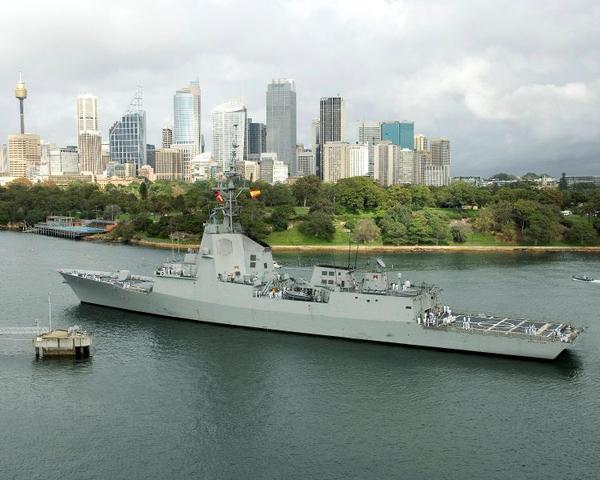
The decision cost the Aussies 16 missile tubes...but the loss of tonnage and the use of an already existing design resulted in a large manpower savings and a sufficient cost savings to allow them to buy a fourth destroyer for nearly the same money as 3. Additionally since this is a design that has been built...the bugs are already largely worked out so the cost overruns are less likely.
According to Eagle 1 the Aussies learned their lesson from the Collins submarine acquisition, in which they got one of the best diesel subs on earth, but could only afford a few and they are expensive to maintain.
The USN is facing challenges in maintaining even a 313 ship navy in part because it buys the absolute best of everything. While it is important to have the top tier vessels like subs and carriers be top of the line, escorts need to be built in numbers, not just for screening the capital ships, but for escorting civilian convoys and detached duties. As Brickmuppet Blog has pointed out before, the best often is the enemy of good enough.
It should be noted in passing that the Spanish design is one of the AFCOM (Advanced frigate consortium) designs and as such can be built by Bath Iron Works.
Update: In the comments, the mysterious "leesea" points out that CDR Salamander posted the analysis of Joe Katzman of Defense Industry Daily.
One of the Spanish vessels is seen here visiting Sydney.

The decision cost the Aussies 16 missile tubes...but the loss of tonnage and the use of an already existing design resulted in a large manpower savings and a sufficient cost savings to allow them to buy a fourth destroyer for nearly the same money as 3. Additionally since this is a design that has been built...the bugs are already largely worked out so the cost overruns are less likely.
According to Eagle 1 the Aussies learned their lesson from the Collins submarine acquisition, in which they got one of the best diesel subs on earth, but could only afford a few and they are expensive to maintain.
The USN is facing challenges in maintaining even a 313 ship navy in part because it buys the absolute best of everything. While it is important to have the top tier vessels like subs and carriers be top of the line, escorts need to be built in numbers, not just for screening the capital ships, but for escorting civilian convoys and detached duties. As Brickmuppet Blog has pointed out before, the best often is the enemy of good enough.
It should be noted in passing that the Spanish design is one of the AFCOM (Advanced frigate consortium) designs and as such can be built by Bath Iron Works.
Update: In the comments, the mysterious "leesea" points out that CDR Salamander posted the analysis of Joe Katzman of Defense Industry Daily.
Posted by: The Brickmuppet at
09:12 PM
| Comments (1)
| Add Comment
Post contains 275 words, total size 2 kb.
May 11, 2008
What could we buy for 6 NSC's? Comparison shoping...
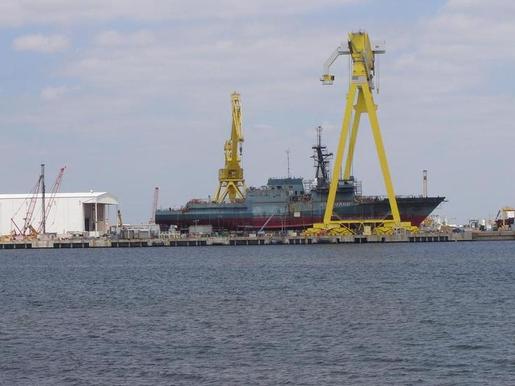
The second of the Legend class, USCGC WAESCHE WMEC 751 is nearing completion and is naturally under considerable scrutiny regards quality control and design issues learned in BERTHOLF.
The Fiasco that has been the National Security Cutter program has led to some laypeople to propose putting a fork in it.
The response of course is that the ships are still needed, restarting the program would be expensive and would not take into account the hull specific lessons learned with the lead vessel.
If all lessons are learned and this ship is completed without the issues of its predecessor then the Coast Guard will have a very fine ship indeed. EVERYTHING I have hard about these vessels design is that they embody every thing that cuttermen have been asking for for 30 years.
Of course it is expensive, the best costs a lot.
The best can also be the enemy of the good.
These high endurance cutters, if they don't have any cost overruns will cost over 450 million dollars apiece....for offshore patrol vessels.
I recently blundered onto this PDF, which is concerned with the state of the Australian shipbuilding industry. This is interesting because at the bottom there is a list of most of the ships built in Australia in the last few years...and their costs....in US Dollars!
Australia has been building a lot of well regarded low end naval vessels for various countries....lets see what those countries are paying and what they get.
New Zealand has ordered a series of offshore patrol vessels from the Australian firm of Tenix.
These are actually designed by the Finnish firm of Aker which designed the Healy as well as the new Mackinaw. They are ice strengthened and designed to serve in the horrific conditions of the southern ocean, which is broadly comparable to the Bering Sea in sheer nastiness. A good overview of them is here.
They are slower than the WMEC 750's and they are certainly inferior in some respects, but they cost 45 million. The WMEC 750's cost 450+million (and the Bertholf is breaking 600 mil)..thus being generous and going with the promised rather than demonstrated cost one comes up with.....
10 of these for one NSC...or 60 of these vessels for the cost of the remaining 6 Legends.
The finest ship in the world can only be one place at a time...as the Russians like to say, quantity has a quality all its own.
Going down the scale we find another Tenix design. This time for the Philippine Coast Guard, the 56m San Juan class provides broadly similar capabilities to the Coast Guards 210' Reliance class. They are slightly smaller, have about half the crew and 6 knots faster. A company brochure on them is here and there is an industry analysis of their construction here.
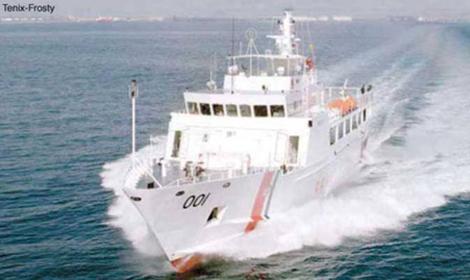
They are fitted for (but not with) a 25-35mm auto-cannon on the foredeck (a strong point and provision for a magazine are provided) and carry such gold plated items as a decompression chamber for diver mishaps and a rescue/triage compartment for 300 people! At 25 knots they are slower than the USCG would like but unlike the Otago class mentioned above they are developed from a fast attack craft, thus their hulls are likely more amenable to high speed with uprated engines. Of course the Phillipine CG chose these engines for their outstanding fuel efficiency...something that is likely to become more pressing than 3-4 knots speed. No helicopter hangar but they have a pad and at any rate at 183 feet long are close to the USCGs high end patrol boats, of the Cyclone class. (The CG is short of patrol boats btw.)
The low balled cost of one WHEC750 would buy 23 of these vessels. All 6 would provide us with 138 patrol boats...with helicopter decks.
Golly....
This SAR vessel is the break point between the medium endurance cutter and patrol boat. The Australian firm of Austal, which is involved in the LCS contract provides the Royal Australian Navy with a similarly sized patrol boat, the Armidale class. These vessels have no helicopter deck but have a 30mm gun two large rescue/inspection craft, a speed of 26 knots and are designed for patrol in the hellish southern ocean as well as SAR ops in the teeth of Willie Willies. They are very seaworthy for their size and are reportedly highly regarded.
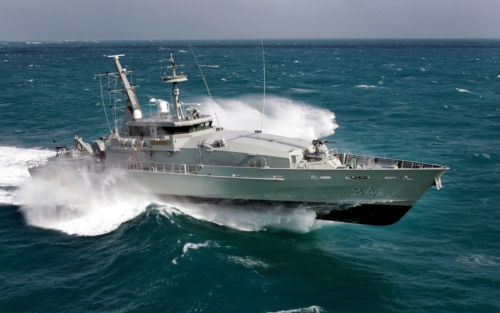
At 14 million apiece 32 could be purchased for the cost of one WHEC750 or 182 could be had for the cost of the rest of the program.
Golly willakers....
Tenix makes a broadly similar steel hulled, ice strengthened vessel for the Kiwis that is a bit more expensive at 20million a pop.
Due to the size restrictions of many small boat stations, the Coast Guard prefers its patrol boats to be somewhat smaller than this, which is one reason we didn't simply build more of the successful WPC179's.
Helpfully Tenix provides a smaller companion to its 56m Search and Rescue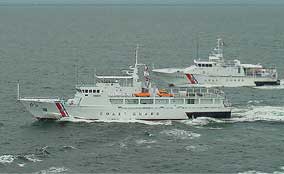 Vessel....The 35 Meter patrol boat is very much more in line with USCG ideas on patrol boats....seen here behind one of her larger half sisters.
Vessel....The 35 Meter patrol boat is very much more in line with USCG ideas on patrol boats....seen here behind one of her larger half sisters.
30 kts, a 30mm gun and a rescuee/triage area (not included in the PDF) . At 8 million dollars apiece thats 56 per NSC and for the program...336
Jeepers Golly Willakers!!
OK this is getting silly...pier space alone is an issue not to mention 6720 cuttermen if the vessels have a realistic crew of 20 in CG service.
There are lots of designs from around the world including, I'm sure the US, I just found numbers for the Aussie designs.
In an operational area as big as that of the USCG some large cutters are certainly necessary, and a far larger number of small patrol boats is desirable. Also the NSC program is not the alpha and omega of USCG budget.
The point of this above the paygrade rant is to suggest that we could spend the money better than on 8 ships, we plan to run ragged. This is true however fine the ships in question may be.
We could buy scads of cruising and inshore patrol cutters and use the money saved to buy a few icebreakers which we have to buy anyway, or even airships.....which are certainly cool , but I don't have any cost info.
UPDATE:
Spelling, syntax errors fixed.
There are many things that the linked PDF does not cover, including life cycle costs, such as fuel consumption and manning. As stated previously...contractor quality control issues notwithstanding, the Legend Class is a very impressive design. The purpose of the post is not to bash that design, but rather to ask if that capability is worth the reduction in unit numbers it inevitably entails.
Welcome readers of Unofficial Coast Guard Blog and Information Dissemination . This blog has no format and generally deals with fluff, but, if this interests you, then you might peruse the category list, particularly weapons n' kit and Maritime Matters ....Thanks for stopping by!

The second of the Legend class, USCGC WAESCHE WMEC 751 is nearing completion and is naturally under considerable scrutiny regards quality control and design issues learned in BERTHOLF.
The Fiasco that has been the National Security Cutter program has led to some laypeople to propose putting a fork in it.
The response of course is that the ships are still needed, restarting the program would be expensive and would not take into account the hull specific lessons learned with the lead vessel.
If all lessons are learned and this ship is completed without the issues of its predecessor then the Coast Guard will have a very fine ship indeed. EVERYTHING I have hard about these vessels design is that they embody every thing that cuttermen have been asking for for 30 years.
Of course it is expensive, the best costs a lot.
The best can also be the enemy of the good.
These high endurance cutters, if they don't have any cost overruns will cost over 450 million dollars apiece....for offshore patrol vessels.
I recently blundered onto this PDF, which is concerned with the state of the Australian shipbuilding industry. This is interesting because at the bottom there is a list of most of the ships built in Australia in the last few years...and their costs....in US Dollars!
Australia has been building a lot of well regarded low end naval vessels for various countries....lets see what those countries are paying and what they get.
New Zealand has ordered a series of offshore patrol vessels from the Australian firm of Tenix.
These are actually designed by the Finnish firm of Aker which designed the Healy as well as the new Mackinaw. They are ice strengthened and designed to serve in the horrific conditions of the southern ocean, which is broadly comparable to the Bering Sea in sheer nastiness. A good overview of them is here.
They are slower than the WMEC 750's and they are certainly inferior in some respects, but they cost 45 million. The WMEC 750's cost 450+million (and the Bertholf is breaking 600 mil)..thus being generous and going with the promised rather than demonstrated cost one comes up with.....
10 of these for one NSC...or 60 of these vessels for the cost of the remaining 6 Legends.
The finest ship in the world can only be one place at a time...as the Russians like to say, quantity has a quality all its own.
Going down the scale we find another Tenix design. This time for the Philippine Coast Guard, the 56m San Juan class provides broadly similar capabilities to the Coast Guards 210' Reliance class. They are slightly smaller, have about half the crew and 6 knots faster. A company brochure on them is here and there is an industry analysis of their construction here.

They are fitted for (but not with) a 25-35mm auto-cannon on the foredeck (a strong point and provision for a magazine are provided) and carry such gold plated items as a decompression chamber for diver mishaps and a rescue/triage compartment for 300 people! At 25 knots they are slower than the USCG would like but unlike the Otago class mentioned above they are developed from a fast attack craft, thus their hulls are likely more amenable to high speed with uprated engines. Of course the Phillipine CG chose these engines for their outstanding fuel efficiency...something that is likely to become more pressing than 3-4 knots speed. No helicopter hangar but they have a pad and at any rate at 183 feet long are close to the USCGs high end patrol boats, of the Cyclone class. (The CG is short of patrol boats btw.)
The low balled cost of one WHEC750 would buy 23 of these vessels. All 6 would provide us with 138 patrol boats...with helicopter decks.
Golly....
This SAR vessel is the break point between the medium endurance cutter and patrol boat. The Australian firm of Austal, which is involved in the LCS contract provides the Royal Australian Navy with a similarly sized patrol boat, the Armidale class. These vessels have no helicopter deck but have a 30mm gun two large rescue/inspection craft, a speed of 26 knots and are designed for patrol in the hellish southern ocean as well as SAR ops in the teeth of Willie Willies. They are very seaworthy for their size and are reportedly highly regarded.

At 14 million apiece 32 could be purchased for the cost of one WHEC750 or 182 could be had for the cost of the rest of the program.
Golly willakers....
Tenix makes a broadly similar steel hulled, ice strengthened vessel for the Kiwis that is a bit more expensive at 20million a pop.
Due to the size restrictions of many small boat stations, the Coast Guard prefers its patrol boats to be somewhat smaller than this, which is one reason we didn't simply build more of the successful WPC179's.
Helpfully Tenix provides a smaller companion to its 56m Search and Rescue
 Vessel....The 35 Meter patrol boat is very much more in line with USCG ideas on patrol boats....seen here behind one of her larger half sisters.
Vessel....The 35 Meter patrol boat is very much more in line with USCG ideas on patrol boats....seen here behind one of her larger half sisters. 30 kts, a 30mm gun and a rescuee/triage area (not included in the PDF) . At 8 million dollars apiece thats 56 per NSC and for the program...336
Jeepers Golly Willakers!!
OK this is getting silly...pier space alone is an issue not to mention 6720 cuttermen if the vessels have a realistic crew of 20 in CG service.
There are lots of designs from around the world including, I'm sure the US, I just found numbers for the Aussie designs.
In an operational area as big as that of the USCG some large cutters are certainly necessary, and a far larger number of small patrol boats is desirable. Also the NSC program is not the alpha and omega of USCG budget.
The point of this above the paygrade rant is to suggest that we could spend the money better than on 8 ships, we plan to run ragged. This is true however fine the ships in question may be.
We could buy scads of cruising and inshore patrol cutters and use the money saved to buy a few icebreakers which we have to buy anyway, or even airships.....which are certainly cool , but I don't have any cost info.
UPDATE:
Spelling, syntax errors fixed.
There are many things that the linked PDF does not cover, including life cycle costs, such as fuel consumption and manning. As stated previously...contractor quality control issues notwithstanding, the Legend Class is a very impressive design. The purpose of the post is not to bash that design, but rather to ask if that capability is worth the reduction in unit numbers it inevitably entails.
Welcome readers of Unofficial Coast Guard Blog and Information Dissemination . This blog has no format and generally deals with fluff, but, if this interests you, then you might peruse the category list, particularly weapons n' kit and Maritime Matters ....Thanks for stopping by!
Posted by: The Brickmuppet at
01:22 PM
| Comments (4)
| Add Comment
Post contains 1177 words, total size 9 kb.
May 10, 2008
Use What you Have...Or Throw a Fit?
Over at the Unofficial Coast Guard Blog, Peter Stinson is feeling played.
I am respectfully in disagreement.
Here is the deal. The Coast Guard bought a super whammodyne cutter some time ago. Named after the first Commandant of the Coast Guard, it is the largest vessel other than icebreakers the USCG has ever purchased.
It is bigger than a Perry Class frigate, has an innovative stern launch arrangement for its boats. It can conduct helicopter operations in Sea State 6. It brings together all the lessons learned from over 2 centuries of institutional expertise. It is ...on paper...a spectacular vessel.
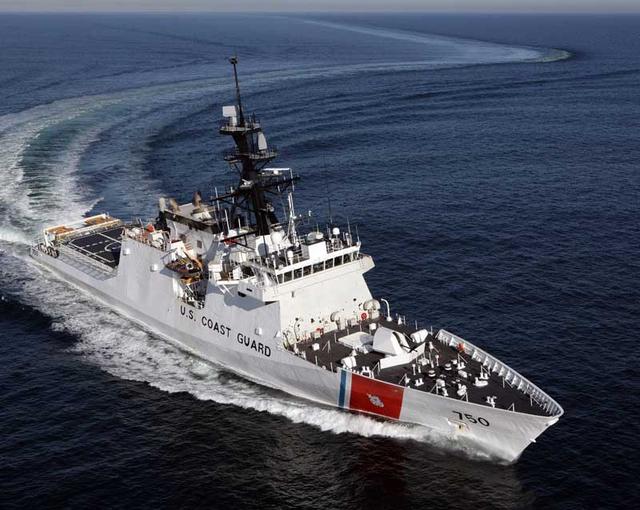
As you likely guessed from the mention of paper in that sentence...it also has, as they say..."issues".
There have been concerns raised about weather the vessel will meet its planned 30 year service life (It won't unless it gets a structural refit in the next 4-6 years). The vessel costs more than the entire defense budget of Ecuador, and its C4I system is not secure.
This last is possibly the most important and expensive. The communication, command, control, computing and intelligence system needs to be absolutely secure electronically. The Bertholf's leaks like a sieve.
Now the Coast Guard has certified the Cutter as seaworthy and allowed her to be commissioned. The ship passed her trial run and was given a clean bill of health by the Navy and Coast Guard.
They did this despite the fact that the C4I system is insecure and cannot be used for any encrypted messages.
This has some people up in arms, and while their upsettedness over the Bertholf is understandable (this thing has been a fiasco) I think that the anger over this particular bureaucratic maneuver is misplaced.
A few weeks ago Admiral Rosa came and talked to our unit about various Coast Guard issues, inspected the troops and took questions.
Naturally, Deepwater came up.
The Admiral said that the aviation component of the Deepwater Program was proceeding quite well but that there had been many expensive lessons learned on the maritime side.
We were told that the structural issues on Bertholf were rather overblown and would not affect seaworthiness or safety and that the C4I issue was in fact the big problem. The ship will commission though it will take a long time to get the C4I stuff TEMPEST certified. The vessel is still a useful asset and will be capable of doing Search And Rescue and other operations without TEMPEST standards being met.
(TEMPEST is a set of standards for military communications and that is all we will say on that.)
This is jives pretty well with the facts as we know them.....no real sinister cover up going on regards this. Its the most obvious solution to the problem. It is heads and shoulders over David Axe's proposal.
While his idea has appeal on a visceral level, the cathartic payoff of such a drama queen temper tantrum does not compensate for the loss of a still useful ship at a time the USCG's assets are stretched thin and at the end of their operational lives.
Despite the expense and gravity of the procurement debacle, I see no reason to get the vapors over this particular decision. Getting the ship certified for sea duty sans its full C4I suite was, IMHO, the correct thing to do. I assume the ship can even operate with bolt on encrypted radios from, say, the Army if it comes down to it.
Having a 500 million dollar "Building 750" sitting as a humiliation to the Coast Guard does not save any mariners in distress nor leverage any good out of this situation.
Now lots of people are anxious to see the heads of Admirals roll over this debacle. This is understandable. However, it now seems that most, if not all of the wrongdoing was on the civilian side, in particular a civilian who signed a document waiving the security standards for the contract....which he was not authorized to do, but is a get out of jail free card for the contractor.
The Coast Guard has not had much experience in procurement for the simple reason that we haven't been able to buy a lot. The only recent experience was with the 87's, the buoy tenders and the Healy. All went (er...relatively) smoothly as I understand it in part because the shipyards in question were small, civilian and generally ethically run....certainly in comparison with those who make money off the byzantine DOD procurement system.
The officers who took this job certainly did not cover themselves in glory, but it is unclear that they were incompetent or negligent as opposed to simply being inexperienced and unsupported in these matters. The contractor in question successfully butt-raped the Navy with regards to the LPD 17. Keep in mind that the USN has far more experience in dealing with defense contractors.
In the military, discipline and professional development is not about vengeance, it is about correcting mistakes and preventing their repetition.
Throwing senior officers overboard because they got set up for failure might give David Axe a woody, but it is not good leadership. To the extent that the Commandant is standing by and protecting his officers, many of whom have had long and honorable careers in the service of their country, he is doing exactly what good chiefs do for their enlisted people every day.
The priority now is to learn what went wrong, apply those lessons, see that this doesn't happen again and get the ship and her sister operational.
If there WAS wrongdoing on the part of any USCG officers then there is always a dark place in Leavenworth, but I think the Commandant is doing the proper thing trying to fix the problem rather than hunt for scapegoats.
I'm a third class enlisted and these issues are waaay above my paygrade, but the whole thing at this point seems to be beating a dead horse.
The ship has defective, insecure coms, and I would expect that the repair of the C4I system is going to be along the lines of George Washington's Axe.
However, it is not unseaworthy, it is new, big and capable of doing many things but is of limited use at a pier.
The USCG certified the ship as commissioned so they can use an imperfect asset to save lives and such. In order to do so they used "Yeoman-fu" to bend the pencil so they could ignore the broken radios and yet still accept the ship.
This seems like a reasonable response to a bad situation.
Of all the mistakes and screw ups that have occurred with the construction of this vessel, this pragmatic decision seems to be the last thing one would get upset about.
I am respectfully in disagreement.
Here is the deal. The Coast Guard bought a super whammodyne cutter some time ago. Named after the first Commandant of the Coast Guard, it is the largest vessel other than icebreakers the USCG has ever purchased.
It is bigger than a Perry Class frigate, has an innovative stern launch arrangement for its boats. It can conduct helicopter operations in Sea State 6. It brings together all the lessons learned from over 2 centuries of institutional expertise. It is ...on paper...a spectacular vessel.

As you likely guessed from the mention of paper in that sentence...it also has, as they say..."issues".
There have been concerns raised about weather the vessel will meet its planned 30 year service life (It won't unless it gets a structural refit in the next 4-6 years). The vessel costs more than the entire defense budget of Ecuador, and its C4I system is not secure.
This last is possibly the most important and expensive. The communication, command, control, computing and intelligence system needs to be absolutely secure electronically. The Bertholf's leaks like a sieve.
Now the Coast Guard has certified the Cutter as seaworthy and allowed her to be commissioned. The ship passed her trial run and was given a clean bill of health by the Navy and Coast Guard.
They did this despite the fact that the C4I system is insecure and cannot be used for any encrypted messages.
This has some people up in arms, and while their upsettedness over the Bertholf is understandable (this thing has been a fiasco) I think that the anger over this particular bureaucratic maneuver is misplaced.
A few weeks ago Admiral Rosa came and talked to our unit about various Coast Guard issues, inspected the troops and took questions.
Naturally, Deepwater came up.
The Admiral said that the aviation component of the Deepwater Program was proceeding quite well but that there had been many expensive lessons learned on the maritime side.
We were told that the structural issues on Bertholf were rather overblown and would not affect seaworthiness or safety and that the C4I issue was in fact the big problem. The ship will commission though it will take a long time to get the C4I stuff TEMPEST certified. The vessel is still a useful asset and will be capable of doing Search And Rescue and other operations without TEMPEST standards being met.
(TEMPEST is a set of standards for military communications and that is all we will say on that.)
This is jives pretty well with the facts as we know them.....no real sinister cover up going on regards this. Its the most obvious solution to the problem. It is heads and shoulders over David Axe's proposal.
If the Coast Guard were truly responsible stewards of the taxpayer’s money, the service would have rejected the ship, returned it to builder Northrop and electronics maker Lockheed, and demanded a refund.
While his idea has appeal on a visceral level, the cathartic payoff of such a drama queen temper tantrum does not compensate for the loss of a still useful ship at a time the USCG's assets are stretched thin and at the end of their operational lives.
Despite the expense and gravity of the procurement debacle, I see no reason to get the vapors over this particular decision. Getting the ship certified for sea duty sans its full C4I suite was, IMHO, the correct thing to do. I assume the ship can even operate with bolt on encrypted radios from, say, the Army if it comes down to it.
Having a 500 million dollar "Building 750" sitting as a humiliation to the Coast Guard does not save any mariners in distress nor leverage any good out of this situation.
Now lots of people are anxious to see the heads of Admirals roll over this debacle. This is understandable. However, it now seems that most, if not all of the wrongdoing was on the civilian side, in particular a civilian who signed a document waiving the security standards for the contract....which he was not authorized to do, but is a get out of jail free card for the contractor.
The Coast Guard has not had much experience in procurement for the simple reason that we haven't been able to buy a lot. The only recent experience was with the 87's, the buoy tenders and the Healy. All went (er...relatively) smoothly as I understand it in part because the shipyards in question were small, civilian and generally ethically run....certainly in comparison with those who make money off the byzantine DOD procurement system.
The officers who took this job certainly did not cover themselves in glory, but it is unclear that they were incompetent or negligent as opposed to simply being inexperienced and unsupported in these matters. The contractor in question successfully butt-raped the Navy with regards to the LPD 17. Keep in mind that the USN has far more experience in dealing with defense contractors.
In the military, discipline and professional development is not about vengeance, it is about correcting mistakes and preventing their repetition.
Throwing senior officers overboard because they got set up for failure might give David Axe a woody, but it is not good leadership. To the extent that the Commandant is standing by and protecting his officers, many of whom have had long and honorable careers in the service of their country, he is doing exactly what good chiefs do for their enlisted people every day.
The priority now is to learn what went wrong, apply those lessons, see that this doesn't happen again and get the ship and her sister operational.
If there WAS wrongdoing on the part of any USCG officers then there is always a dark place in Leavenworth, but I think the Commandant is doing the proper thing trying to fix the problem rather than hunt for scapegoats.
I'm a third class enlisted and these issues are waaay above my paygrade, but the whole thing at this point seems to be beating a dead horse.
The ship has defective, insecure coms, and I would expect that the repair of the C4I system is going to be along the lines of George Washington's Axe.
However, it is not unseaworthy, it is new, big and capable of doing many things but is of limited use at a pier.
The USCG certified the ship as commissioned so they can use an imperfect asset to save lives and such. In order to do so they used "Yeoman-fu" to bend the pencil so they could ignore the broken radios and yet still accept the ship.
This seems like a reasonable response to a bad situation.
Of all the mistakes and screw ups that have occurred with the construction of this vessel, this pragmatic decision seems to be the last thing one would get upset about.
Posted by: The Brickmuppet at
11:58 PM
| No Comments
| Add Comment
Post contains 1161 words, total size 8 kb.
<< Page 1 of 1 >>
40kb generated in CPU 0.0219, elapsed 0.0342 seconds.
29 queries taking 0.0259 seconds, 82 records returned.
Powered by Minx 1.1.6c-pink.
29 queries taking 0.0259 seconds, 82 records returned.
Powered by Minx 1.1.6c-pink.









